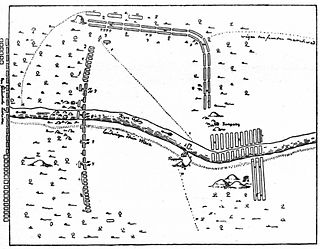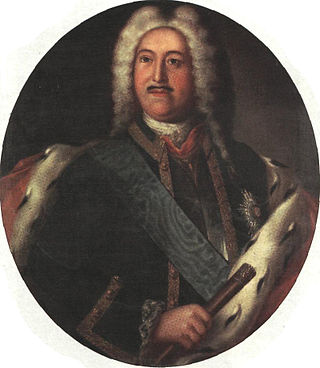Related Research Articles

1809 (MDCCCIX) was a common year starting on Sunday of the Gregorian calendar and a common year starting on Friday of the Julian calendar, the 1809th year of the Common Era (CE) and Anno Domini (AD) designations, the 809th year of the 2nd millennium, the 9th year of the 19th century, and the 10th and last year of the 1800s decade. As of the start of 1809, the Gregorian calendar was 12 days ahead of the Julian calendar, which remained in localized use until 1923.

1728 (MDCCXXVIII) was a leap year starting on Thursday of the Gregorian calendar and a leap year starting on Monday of the Julian calendar, the 1728th year of the Common Era (CE) and Anno Domini (AD) designations, the 728th year of the 2nd millennium, the 28th year of the 18th century, and the 9th year of the 1720s decade. As of the start of 1728, the Gregorian calendar was 11 days ahead of the Julian calendar, which remained in localized use until 1923.

1779 (MDCCLXXIX) was a common year starting on Friday of the Gregorian calendar and a common year starting on Tuesday of the Julian calendar, the 1779th year of the Common Era (CE) and Anno Domini (AD) designations, the 779th year of the 2nd millennium, the 79th year of the 18th century, and the 10th and last year of the 1770s decade. As of the start of 1779, the Gregorian calendar was 11 days ahead of the Julian calendar, which remained in localized use until 1923.

1714 (MDCCXIV) was a common year starting on Monday of the Gregorian calendar and a common year starting on Friday of the Julian calendar, the 1714th year of the Common Era (CE) and Anno Domini (AD) designations, the 714th year of the 2nd millennium, the 14th year of the 18th century, and the 5th year of the 1710s decade. As of the start of 1714, the Gregorian calendar was 11 days ahead of the Julian calendar, which remained in localized use until 1923.

The Battle of Lesnaya was one of the major battles of the Great Northern War. It took place on October 9 [O.S. September 28] 1708 between a Russian army of between 26,500 and 29,000 men commanded by Peter I of Russia, Mikhail Mikhailovich Golitsyn, Aleksandr Danilovich Menshikov, Christian Felix Bauer and Nikolai Grigorovitj von Werden and a Swedish army of about 12,500 men commanded by Adam Ludwig Lewenhaupt and Berndt Otto Stackelberg, at the village of Lesnaya, located close to the border between the Polish–Lithuanian Commonwealth and Russia. The Swedes were escorting a supply column of more than 4,500 wagons for their main army in Ukraine.

The Great Northern War (1700–1721) was a conflict in which a coalition led by the Tsardom of Russia successfully contested the supremacy of the Swedish Empire in Northern, Central and Eastern Europe. The initial leaders of the anti-Swedish alliance were Peter I of Russia, Frederick IV of Denmark–Norway and Augustus II the Strong of Saxony–Poland–Lithuania. Frederick IV and Augustus II were defeated by Sweden, under Charles XII, and forced out of the alliance in 1700 and 1706 respectively, but rejoined it in 1709 after the defeat of Charles XII at the Battle of Poltava. George I of Great Britain and the Electorate of Hanover joined the coalition in 1714 for Hanover and in 1717 for Britain, and Frederick William I of Brandenburg-Prussia joined it in 1715.

Charles XII, sometimes Carl XII or Carolus Rex, was King of Sweden from 1697 to 1718. He belonged to the House of Palatinate-Zweibrücken, a branch line of the House of Wittelsbach. Charles was the only surviving son of Charles XI and Ulrika Eleonora the Elder. He assumed power, after a seven-month caretaker government, at the age of fifteen.

Count Fyodor Matveyevich Apraksin was one of the first Russian admirals, governed Estonia and Karelia from 1712 to 1723, was made general admiral (1708), presided over the Russian Admiralty from 1718 and commanded the Baltic Fleet from 1723.

The House of Golitsyn or Galitzine was a Russian princely family. Among them were boyars, warlords, diplomats, generals, admirals, stewards, chamberlains, and provincial landlords. It is the second largest and noblest Princely house in Russia.
The Great Wrath was a period of Finnish history dominated by the Russian invasion and subsequent Russian military occupation of Finland, then part of the Swedish Empire, from 1714 until the treaty of Nystad (1721), which ended the Great Northern War.

The military history of the Russian Empire encompasses the history of armed conflict in which the Russian Empire participated. This history stretches from its creation in 1721 by Peter the Great, until the Russian Revolution (1917), which led to the establishment of the Soviet Union. Much of the related events involve the Imperial Russian Army, Imperial Russian Navy, and from the early twentieth century, the Imperial Russian Air Service.

The Battle of Gangut took place on 27 JulyJul./ 7 August 1714Greg. during the Great Northern War (1700–1721), in the waters of Riilahti Bay, north of the Hanko Peninsula, near the site of the modern-day city of Hanko, Finland, between the Swedish Navy and Imperial Russian Navy. It was the first important victory of the Russian fleet in its history. It is commemorated in Russia as one of the Days of Military Honour.

The Battle of Grengam, Finnish: Flisön taistelu of 1720 was the last major naval battle in the Great Northern War that took place in Åland, in the Ledsund strait between the island communities of Föglö and Lemland. The battle marked the end of Russian and Swedish offensive naval operations in Baltic waters. The Russian fleet conducted one more raid on the Swedish coast in spring 1721, whereupon the Treaty of Nystad was signed, ending the war.

Archangelgorod Governorate was an administrative-territorial unit (guberniya) of the Tsardom of Russia and the Russian Empire, which existed from 1708 until 1780. Its seat was in Archangel (Arkhangelsk). The governorate was located in the north of the Russian Empire and bordered Siberia Governorate in the east, Kazan Governorate in the southeast, Moscow and Ingermanland Governorates in the southwest, Sweden in the west, and Norway in north-west. In the north, the governorate was limited by the White and Barents Seas.

The Battle of Napue or the Battle of Storkyro / Isokyrö was fought on 19 February 1714 (O.S.) / 2 March 1714 (N.S.) at the villages of Napue and Laurola in the Isokyrö parish of the Swedish Empire between the Swedish Empire and the Tsardom of Russia. It was the final land battle of the Finnish campaign in the Great Northern War. The Swedish detachment, consisting almost entirely of Finnish troops, were defeated by the numerically superior Russian force. As a result, all of Finland fell under Russian military occupation for the rest of the War; a seven-year period of hardship known in Finland as the Great Wrath.

The invasion of Russia by Charles XII of Sweden was a campaign undertaken during the Great Northern War between Sweden and the allied states of Russia, Poland, and Denmark. The invasion began with Charles's crossing of the Vistula on 1 January 1708, and effectively ended with the Swedish defeat in the Battle of Poltava on 8 July 1709, though Charles continued to pose a military threat to Russia for several years while under the protection of the Ottoman Turks.

The Battle of Molyatichi, also known as the Battle of Dobroye, took place on August 31, 1708 at Molyatichi during the Great Northern War. The Russian army of Peter the Great under the command of Mikhail Golitsyn successfully attacked the avantgarde of the Swedish Army of Charles XII under Carl Gustaf Roos. The fighting occurred in the swamp between the rivers Belaya Natopa and Chernaya Natopa. The Swedish force under Roos was surprised by the Russian attack in the morning fog and steadily withdrew towards the main Swedish army. The swampy landscape prevented the Russian cavalry to cut off the Swedish way of retreat. As Swedish reinforcements arrived, the Russians were put on the defensive. Since the attack of the main body of the Swedish army was not part of the Russian intentions at that moment, and to avoid a disastrous defeat, the Russians withdrew. According to the Russian description, this was done in order, while the Swedish one claims their retreat turned into a disorganized flight as the Swedes pursued. Many Russians were killed in the swamps.
Count Ivan Fedoseevich Botsis was a Russian admiral of Greek descent and one of the main founders of the Imperial Russian Navy under Peter the Great.

Prince Mikhail Mikhailovich Golitsyn or Galitzin was a Russian Imperial Army field marshal (1725) and a president of the College of War (1728—1730) from the House of Golitsyn. He was also known as a governor of Finland (1714–1721) during the "Great Discord". From 1728 he was a member of the Supreme Privy Council. He was the son of Mikhail Andreyevich Golitsyn and spouse of Tatyana Borisovna Golitsyna.

Prince Mikhail Mikhailovitch Golitsyn or Galitzin was a Russian admiral and diplomat.
References
![]() Media related to 1714 in Russia at Wikimedia Commons
Media related to 1714 in Russia at Wikimedia Commons